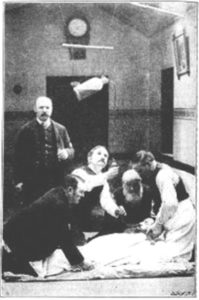
Force Feeding a Patient at the Willard Asylum for the Insane, late 1800s, courtesy The Inmates of Willard
Horror stories abound about the cruelty and sadness of life in an asylum. Especially as asylums became overcrowded and less well-run, it was hard for patients to recover from whatever condition had sent them there. Even worse, the patients’ relatives often had no desire or incentive to bring them home–whether they did get better or not. Sometimes, patients simply had no relatives or friends to return to.
Physicians at asylums had more incentive to discharge patients so that their “cure rates” could go up, but if they had nowhere to send an “improved” or “cured” patient, they might feel they had no choice but to keep them in the asylum. Additionally, many physicians were too busy–or didn’t care enough–to spend much time with patients and couldn’t determine whether or not they had improved. All these factors could lead to a lifetime of treatment for what had been a temporary problem.

Doctors and Administrators at the Florida State Hospital, circa 1920s, courtesy State Archives of Florida
An 1880 report from the Insane Asylum of California summed up the facility’s overall cure rate (since its creation) as just under 47%. This was certainly an admirable rate, but the superintendent also pointed out that very sadly, some patients were being sent to the asylum who more properly belonged to a state hospital or infirmary. He was speaking specifically about patients who were senile or had chronic diseases, but he also mentioned a state law against sending “cases of “idiocy or imbecility, or simple feebleness of mind” to asylums. The law was obviously being ignored.

An Advocate Went a Long Way Toward a Patient’s Release, courtesy Portraits of Eloise blog
Some patients did manage to get out of asylums even though the odds were stacked against them, and I will discuss these cases in an upcoming post(s).